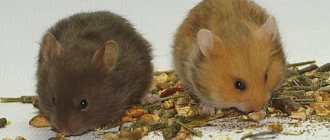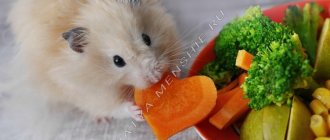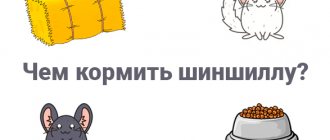Before deciding what to feed your hamster at home, you should contact animal breeders. If you purchased an animal at a pet store, ask the seller what kind of food was given to the baby. Considering that sellers are not able to provide optimal care for rodents, start from the animal’s usual food and supplement it.
What to feed hamsters
If you just bought a pet in a store, take all the contents at once, including a drinking bowl. From food you need to take grain food for hamsters and a mineral stone that does not contain salt.
The grain mixture should be specifically intended for hamsters, and not for birds or other rodents. Do not take drops for rodents: there is too much sugar, the animals do not need it. If the store offers several mixtures, do not take the cheap one. More expensive ones contain the vitamins and minerals your pet needs and are better balanced. If you still decide to take economy class food, buy vitamins for it.
In addition to the dry mixture, it is necessary to feed the animals with succulent food.
Description[ | ]
The body length of the golden hamster is from 50 to 115 mm. The prehensile tail ranges from 50 to 97 mm in length, usually the same length as the hamster's body. Male golden hamsters have a rod with cartilage at the end. Females have six mothers. Vibrissae black or gray[3]. Golden hamsters get their common name from the thick, soft golden fur that covers their upper body. However, the paws and abdomen are white, and the tail is cream-colored. Golden hamster molars contain thick folds of enamel. Like other Muroidea species, golden mice have an infraorbital foramen. There are no canines or premolars. The incisors are sharp and long, separated from the cheek teeth by a diasystem.
Hectographic variability is manifested in the amount of yellowish, reddish and brownish shades in the color of the back. About five subspecies have been described; however, they are all likely to represent a single regional group rather than distinct populations. Populations from the Atlantic coastal plains of Virginia, the Carolinas, and Georgia ( O. n. nuttalli
) somewhat brighter (more reddish-yellow);
populations from Piedmont and the mountainous regions to the west ( O. n. aureolis
) are somewhat more brownish;
populations from Texas, northern Louisiana, Arkansas, Missouri, and Illinois ( O. n. lisae
and
O. n. flammeus
) are more yellowish;
populations from the Florida Peninsula ( O. n. floridanus
) are a rich yellowish-brown color.
Because of their attractive color, golden hamsters are often mentioned in American children's literature, such as the book Poppy
».
What hamsters can and cannot do, food list
The table shows the main food groups of what rodents can and cannot eat:
List of food groups for a hamster's diet
| Must be given continuously as food |
| Dry food for hamsters, legumes except red beans, raw and cooked cereals except rice. Rice is given for diarrhea. Vegetables: root vegetables except potatoes, in season cucumbers and peppers, zucchini, pumpkin. Dill, parsley, lettuce, dandelion. Fruits are sweet, seasonal, seedless. Home dried fruits. Frozen vegetables without onions. Pumpkin, sunflower, melon seeds. Nuts other than almonds and apricot kernels should be given not as the main food, but as a supplement, since nuts are fatty. Sprouted oats, wheat. Branches of deciduous trees boiled for 20 minutes, but not from the street. |
| You need to give one of the positions to choose from 2-3 times a week |
| Boiled chicken breast without salt and other spices; low-fat lactic acid products (fat content no more than 1%); boiled egg white; very rarely meat or boiled shrimp; insects and gammarus purchased in the store; lean boiled fish without bones. |
| Can't give |
| Fried, smoked, salted, pickled, fatty. Sugar, salt, spices, honey. Cream, sour cream and butter. Pasta: both dry and boiled. Citrus fruits, persimmons, onions and garlic, radishes, potatoes, acorns, cabbage, eggplant, tomatoes. Coniferous branches. Insects from the street, bloodworms. Mushrooms, mint and rose hips. |
The table gives general principles on how to feed a hamster; based on them, create your pet’s diet.
What can you give hamsters, food quality
If you have no plans to get rid of the animal in the near future, pay attention to the quality of the food. An animal should not eat “from the trash heap”; moldy grains and rotten fruits are not suitable for children. Meals at home should consist only of fresh and high-quality food.
No one in their right mind would give their pet rotten fruit. But slightly spoiled apples with barrels are also dangerous for animals. A person is not afraid of porridge that has been sitting in the refrigerator for two days, but a hamster can get sick from it.
How to feed animals fruits
Fresh vegetables and fruits can be placed in a cage in large pieces or cut into pieces.
Since you can only feed your hamster fresh food, be sure to remove any leftover succulent food no later than after 8 hours.
Conditions of detention
Golden hamsters love spacious cages. It is best to take a metal one designed for keeping rabbits. Some people prefer to use aquariums, rectangular glass containers or terrariums as cages.
The size of the cage for two hamsters should be 50x40x40 cm. There must be a wooden house inside so that the rodents can take refuge and rest there. In addition, the presence of a house has a beneficial effect on the breeding of offspring. Golden hamsters arrange their own house, dragging straw, paper or scraps of rags there.
The air temperature where the hamsters are located should not be lower than 22 °C. If the temperature drops below that, the animal may hibernate.
Is it possible to give hamsters the same food in winter and summer?
The diet of animals is quite varied. It includes: grains, nuts, fruits and vegetables, protein products. Vegetables and fruits have a seasonal cycle. In the middle zone, cucumbers and plums grow in summer. At this time they contain a lot of vitamins. There will be no benefit from plums for the New Year. It was either grown somewhere far away, or treated with chemicals that protect against spoilage. This product should not be given to an animal. As for watermelons, it is better to exclude them from the diet altogether. They contain a lot of water, and nitrates added during cultivation are perfectly soluble in it.
It is better to prepare fruits in season. To do this, dry apricots and pears, and then add them to your pet. Instead of greenhouse cucumbers, feed the animals carrots and turnips, which retain vitamins well; apples can be given as fruit.
What can you feed a hamster that is left without a mother?
It is a great misfortune if the babies lost their mother at birth or she escaped from the cage.
You'll have to arm yourself with patience and take care of the little hamsters yourself. Of the mixtures, milk is best suited for feeding kittens. You can buy it at a pet store. Give your babies the diluted formula every two hours. After eating, massage their tummy. Give the animals bottles of warm water to prevent them from catching a cold.
As they grow, their diet becomes richer. Add baby purees without salt and sugar to your animals:
- vegetable;
- fruit;
- meat.
Cook porridge with water for them. A month-old animal can be fed with adult food. If necessary, grind it on a grater.
Description
The golden hamster is a small rodent. Body length varies from 13 to 15 cm, weight - 110-150 g. The body is dense, the coat is smooth, the tail is short - no more than 0.5 cm long.
Not only the body, but also the small ears of the rodent are covered with fur of this shade. The golden hamster's legs are stocky and its feet are wide. The eyes are large and black. A distinctive feature of this breed is its ability to constantly fill its cheek pouches with food. Therefore, if you see a golden-colored rodent in the photo, and with cheeks full of food, there is no doubt - this is a Syrian hamster.
Like most breeds of the Hamyakov family, this species is nocturnal. During the day, hamsters sleep, and at night they exercise on a wheel, ladder and other devices for active pastime.
Advantages of the breed
Unlike other dwarf rodents, this species is universal because it is suitable for people of all ages, including children. Golden hamsters are less active than their counterparts due to their weight and size. They don't bite. They can be easily tamed. By its nature, this breed is considered the most obedient and non-aggressive.
Another feature of this species is the need to live alone. This is exactly the species that does not tolerate the proximity of other individuals in the cage. Remember, keeping hamsters of this breed together can lead to irreversible consequences. Such rodents can not only injure each other, but also bite to death.
Until about five weeks of age, young animals can feel comfortable in the community. After this, all individuals need to be seated in different cells. Some rodents may not show any aggression towards each other, but experience severe stress from having to share their territory with other individuals.
Controversial issues or what not to feed a hamster
There are products that cause controversy among animal owners. Is it possible to give milk to animals, how much cheese can you give, and what harm can crackers and bread do?
To answer these questions, we will have to return to the diet of animals in the wild:
- Adult animals do not feed on milk, and the composition of cow's milk is not suitable for young animals. Babies fed bread soaked in milk survive only due to their potential health, and not due to proper feeding.
- You should not feed your pet hamster cheese. It is quite fatty and contains a lot of salt: this will harm the rodent.
- Bread and baked goods are completely inedible for rodents, although they will chew them. There are too many harmful components in the form of fat and sugar in crackers and cookies. If you decide to feed something similar, choose unsweetened dryers. It won't be too useful, but in minimal quantities it won't cause any harm.
What can you feed hamsters?
The closer a hamster's diet is to natural nutrition, the better for the animal. The less the product is processed, the more nutrients are preserved in it.
These rodents are children of the steppe. It's easy to guess what hamsters eat. The basis of their diet is grains of varying degrees of maturity: seeds, grass sprouts. Juicy roots and root vegetables obtained from vegetable stores are also on the menu of these resourceful animals.
Protein food is also necessary for animals. In the wild these are: insects, wounded birds and small animals.
So, the animals’ diet consists of:
- grain mixtures purchased at a pet store;
- juicy vegetables and fruits;
- greenery;
- seeds and nuts;
- low-fat lactic acid products, eggs or chicken breast 2-3 times a week.
The list of products can be supplemented if you have experience in raising such animals. You can make your own grain mixtures or supplement them with grass seeds or cereals.
The cage should contain water and a mineral stone for grinding down the incisors.
Characteristics of the golden hamster
The Syrian hamster is 8 cm long, has a short tail, but a very stocky body. Fur color is golden, yellow, red and brown. The abdomen has a lighter color.
In laboratory conditions, it was possible to develop several varieties of this rodent. The hamster is friendly and does not bite when handled. Due to the active behavior of the animal, it is necessary to be careful and carefully open the cage so that the nimble hamster does not have time to run out to freedom. If the rodent managed to escape, you don’t need to look for it throughout the apartment, just put the cage on the floor and fill the bowl with food. After some time, the hamster will return on its own and climb into the cage.
To get along with your little tenant, you need to be patient. The first time you want to pick up a hamster, it is better to catch it in the dark so as not to scare it. After some time, the hamster can be safely left on a table or other surface for a walk.
Nutrition and care: dangers of improper feeding
It happens that inexperienced pet owners feed their animal seemingly correctly, but get poor results: the animal gains excess weight and digestive problems arise. What could be the reasons:
- the animal is given a lot of treats;
- The animal does not have enough “simulators” at home;
- hamsters' diet consists mainly of ready-made meals: cereals and boiled vegetables
It is unacceptable to feed hamsters this way, even if they like it.
In nature, animals run up to several kilometers a day. They need exercise. In addition to the wheel, for running the cage must have: paths, labyrinths, passages and ladders.
The hamster eats twice a day: morning and evening. The evening portion should be larger, since evening is the peak activity of these nocturnal animals. There is no need to impose restrictions on dry food so as not to create additional stress for the animal. Let the dry mixture remain in the feeder at all times. Change it so that it does not have time to deteriorate. But treats – dose them, especially if they are sweet, if you don’t want to fatten the animal and make it sick.
Syrian golden hamsters: breed characteristics and maintenance
Syrian golden hamsters in a relatively short time have become indispensable assistants to scientists in their work. In scientific and diagnostic laboratories, various infectious diseases are reproduced on hamsters - tuberculosis, brucellosis, glanders, leptospirosis, rabies, foot-and-mouth disease, anthrax, tetanus and many other diseases dangerous to people and farm animals.
Hamsters' track record includes studying vitamin deficiencies, toxicosis, radiation injuries, various issues of physiology, pathomorphology, and pharmacology. The effects of various medications and vaccines are tested on hamsters. They also contribute to the study of malignant tumors, in particular, human leukemia.
History of the discovery of Syrian golden hamsters
Common hamsters are used very rarely in laboratory experiments. Small Syrian hamsters are usually used for mass research.
Until the beginning of the nineteenth century, no one knew about the existence of these cute animals. In 1839, the English zoologist Waterhouse, while studying various animals in Syria, found a rare animal that looked like a hamster. The scientist named the hamster golden for the color of its fur.
After the discovery of this species of hamsters, no one was able to find them in nature for a long time. And only in 1930, a professor at the University of Jerusalem, Aharoni, found a living hole of a golden hamster in approximately the same places. It contained a hamster with a litter of twelve babies. They were all moved to people and began to be observed.
Three hamsters ended up with scientists in England. The animals turned out to be quite unpretentious and began to breed in captivity. Their descendants settled in various European countries and in America. At first they were kept and bred in scientific institutions as representatives of the rarest zoological species - “living fossils”.
Gradually, Syrian hamsters multiplied so much that they ceased to be rare. From scientific laboratories they began to end up in the homes of hobbyists. Currently, golden hamsters have spread literally all over the world. In scientific laboratories, they successfully compete with such veterans as white mice, rats, guinea pigs and rabbits.
Many millions of hamsters are used in laboratories around the world every year. And no one has found Syrian hamsters in nature since the memorable 1930.
Keeping Syrian hamsters
Syrian hamsters, like all rodents, are quite prolific. For breeding, a male and a female at least two months old are selected. Their pregnancy duration is 16-22 days. At the first birth, the female brings 4-5 cubs, and at subsequent births - up to 10 or more. Females feed their young with their milk for 20-25 days. In a year, a hamster can give birth to up to 12-13 litters. This unusually high fertility is explained by the fact that even while feeding her babies with milk, the female already becomes pregnant again. On average, one hamster can produce 70-80 babies per year. In laboratories, a pair of hamsters is used for breeding purposes for no more than a year.
Hamsters are born blind. They become sighted 15-16 days after birth. After about 25 days, they are weaned from their mothers and kept in groups of up to 10. Females and males – separately. At the age of one month, hamsters weigh 35-40 grams, and at two months their weight doubles. Adult hamsters weigh 100-150 grams.
Breeding Syrian hamsters in laboratories and in the homes of hobbyists has led to the emergence of several breeds of them with different coat colors. It is not difficult to keep them, especially since these extremely calm and peaceful animals are quite hardy and very clean. It is only important that the room is clean, light and not damp - after all, they come from the dry desert.
Features of feeding and nutrition
Feeding hamsters is not particularly difficult. They eat whatever is given to them. The main food for them is a grain mixture (oats, wheat, barley can also be given). They gnaw sunflower seeds and eat various greens. They willingly eat all kinds of cereals, pasta, white bread, and do not refuse boiled meat. It is necessary to ensure that their diet contains a sufficient amount of vitamins.
Golden hamsters are interesting for their concerns about food. As autumn approaches, domestic hamsters, like their larger relatives in nature, begin to stock up on food. They arrange their storerooms in a corner of the cage, more often under the nest. They usually do not use the stored food, and it spoils. Therefore, it needs to be cleaned periodically.
All hamsters carry stored food in special cheek pouches. Observations and experiments have shown that in Syrian golden hamsters, the amount of grain collected in the cheek pouches depends on the degree of irritation of the nerve endings of the mucous membrane of these pouches. If you anesthetize the mucous membrane of the cheek pouches, the hamster takes in so much food that it cannot even crawl through the hole into its hole. These same hamsters were able to develop conditioned reflexes to the degree of filling of the cheek pouches. The opening to the experimental cage was narrowed and the hamster, with its cheek pouches swollen, could not get into its pantry. He had to immediately empty his cheek pouches. When such conditions were repeated, the hamster collected so many seeds into its cheek pouches that it could crawl into the house through the narrowed hole.
Lifestyle of Syrian hamsters
Hamsters lead a crepuscular and nocturnal lifestyle. Both in homes and in laboratories these habits do not change. During the day they sleep quietly and calmly in their nest. And as soon as evening comes, they develop vigorous activity. They are gnawing on something, rustling, rebuilding their home.
Manufacturer information
]Bio Nursery STESAR[/anchor] offers to buy golden Syrian hamsters.
All our laboratory animals are raised in a nursery located in an ecologically clean natural area. All company products are certified in accordance with the Regulations on quality control of nurseries and experimental biological clinics (vivariums), as well as in accordance with National, Regional, International, Industry standards and technical regulations.
For delivery we use our own heated isothermal transport
Products
- Non-linear ICR mice (CD-1)
- Linear mice: CBA (Lac), c57Bl/6, Balb/c, F1 hybrids
- Guinea pigs "Agouti"
- Rabbits Soviet chinchilla
- Wistar rats
- Non-linear rats
What do dwarf hamsters eat?
Feeding Djungarians is practically no different from feeding Syrian hamsters, with one exception. Children are susceptible to diabetes. For this reason, hamsters should not be given sweet fruits as their main diet. It is better to limit yourself to rare cases and give such fruits in small quantities.











